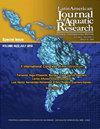感染不同白斑综合征病毒(WSSV)株的凡纳滨对虾原代血细胞培养中基因表达的研究
IF 0.8
4区 农林科学
Q3 FISHERIES
Latin American Journal of Aquatic Research
Pub Date : 2022-08-31
DOI:10.3856/vol50-issue4-fulltext-2816
引用次数: 0
摘要
从墨西哥西北部选取了5株先前分析过的基因组结构和毒力不同的白斑综合征病毒(WSSV)毒株(高毒力JP和LG毒株;中等毒力的GVE和DIV菌株;和低毒力LC10菌株)来评估体外发病反应。采用qPCR方法检测凡纳滨对虾原代血细胞感染后1、3、6、12和24 h (hpi)吞噬激活蛋白PAP、锰超氧化物歧化酶MnSOD和过氧化物还蛋白PRX以及两个早期表达基因IE1和WSSV304的表达。PAP在1和3 hpi时表达量显著升高,其中JP和LC10表达量最高。MnSOD在1 hpi时反应高,PRX在3 hpi时表达显著增加,可能是由于氧化爆发的发生;LG菌株(高毒力)诱导的MnSOD和PRX分别在1和3 hpi时表达水平显著升高,提示急性反应。一般来说,大多数免疫相关基因的表达在感染的最初几个小时后下降。IE1和WSSV304在几乎所有5个WSSV分析菌株中在1 hpi时的表达水平都异常高,证实了它们的高效复制机制和病毒适应性。尽管基因组最小的菌株显示出最高的毒力,但本研究的结果并未显示出基因组大小与菌株的WSSV毒力之间的准确联系。所有菌株都以不同的方式诱导早期免疫反应。本文章由计算机程序翻译,如有差异,请以英文原文为准。
Gene expression in primary hemocyte culture of the Pacific white shrimp Penaeus vannamei infected with different white spot syndrome virus (WSSV) strains
Five previously analyzed white spot syndrome virus (WSSV) strains from northwest Mexico, differing in their genome architecture as well as in virulence, were selected (high virulence JP and LG strains; moderate virulence GVE and DIV strains; and low virulence LC10 strain) to evaluate pathogenesis response in vitro. Expression of phagocytosis-activating protein PAP, manganese superoxide dismutase MnSOD and peroxiredoxin PRX, and two genes of immediate-early expression (IE1 and WSSV304) were measured by qPCR in a primary hemocyte cell culture from Penaeus vannamei at 1, 3, 6, 12, and 24 h post-infection (hpi). PAP expression was significantly higher at 1 and 3 hpi, and JP and LC10 strains induced the highest expression. The response of MnSOD was high at 1 hpi, and a significant increase in PRX expression was detected at 3 hpi, probably due to the occurrence of an oxidative burst; expression levels of MnSOD and PRX were significantly higher at 1 and 3 hpi, respectively, induced by the LG strain (high virulence), suggesting an acute response. In general, expression of most immune-related - genes decreased after the initial hours of infection. Expression levels of IE1 and WSSV304 were exceptionally high at 1 hpi in almost all five WSSV analyzed strains, confirming their efficient mechanism for replication and viral fitness. The results of this study do not show an accurate link between the genome size and WSSV virulence of the strains, albeit the strain with the smallest genome showed the highest virulence. All strains induced an early immune response in heterogeneous ways.
求助全文
通过发布文献求助,成功后即可免费获取论文全文。
去求助
来源期刊

Latin American Journal of Aquatic Research
FISHERIES-MARINE & FRESHWATER BIOLOGY
CiteScore
1.70
自引率
10.00%
发文量
44
审稿时长
4-8 weeks
期刊介绍:
Latin American Journal of Aquatic Research- LAJAR is the continuation of the journal Investigaciones Marinas (1970-2007) and is published since 2008 by the Escuela de Ciencias del Mar, Facultad de Ciencias del Mar y Geografía of the Pontificia Universidad Católica de Valparaíso. LAJAR is an “Open Access” journal that publishes in English language, original research articles, reviews and short communications on aquatic science, which contain the results of research conducted in aquaculture or in oceanic and coastal marine waters of Latin America.
The following topics are considered: Physical Oceanography, Chemical Oceanography, Marine Biogeochemistry, Marine Pollution and Toxicology, Marine Geology and Geophysics, Biological Oceanography, Fisheries and Aquaculture.
 求助内容:
求助内容: 应助结果提醒方式:
应助结果提醒方式:


